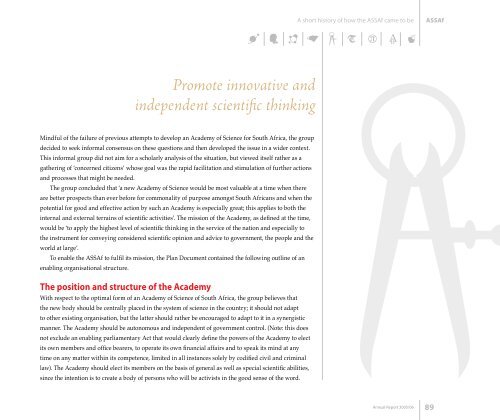Academy of Science South Africa 2005/6 Annual Report
Academy of Science South Africa 2005/6 Annual Report
Academy of Science South Africa 2005/6 Annual Report
- No tags were found...
Create successful ePaper yourself
Turn your PDF publications into a flip-book with our unique Google optimized e-Paper software.
A short history <strong>of</strong> how the ASSAf came to beASSAfPromote innovative andindependent scientific thinkingMindful <strong>of</strong> the failure <strong>of</strong> previous attempts to develop an <strong>Academy</strong> <strong>of</strong> <strong>Science</strong> for <strong>South</strong> <strong>Africa</strong>, the groupdecided to seek informal consensus on these questions and then developed the issue in a wider context.This informal group did not aim for a scholarly analysis <strong>of</strong> the situation, but viewed itself rather as agathering <strong>of</strong> ‘concerned citizens’ whose goal was the rapid facilitation and stimulation <strong>of</strong> further actionsand processes that might be needed.The group concluded that ‘a new <strong>Academy</strong> <strong>of</strong> <strong>Science</strong> would be most valuable at a time when thereare better prospects than ever before for commonality <strong>of</strong> purpose amongst <strong>South</strong> <strong>Africa</strong>ns and when thepotential for good and effective action by such an <strong>Academy</strong> is especially great; this applies to both theinternal and external terrains <strong>of</strong> scientific activities’. The mission <strong>of</strong> the <strong>Academy</strong>, as defined at the time,would be ‘to apply the highest level <strong>of</strong> scientific thinking in the service <strong>of</strong> the nation and especially tothe instrument for conveying considered scientific opinion and advice to government, the people and theworld at large’.To enable the ASSAf to fulfil its mission, the Plan Document contained the following outline <strong>of</strong> anenabling organisational structure.The position and structure <strong>of</strong> the <strong>Academy</strong>With respect to the optimal form <strong>of</strong> an <strong>Academy</strong> <strong>of</strong> <strong>Science</strong> <strong>of</strong> <strong>South</strong> <strong>Africa</strong>, the group believes thatthe new body should be centrally placed in the system <strong>of</strong> science in the country; it should not adaptto other existing organisation, but the latter should rather be encouraged to adapt to it in a synergisticmanner. The <strong>Academy</strong> should be autonomous and independent <strong>of</strong> government control. (Note: this doesnot exclude an enabling parliamentary Act that would clearly define the powers <strong>of</strong> the <strong>Academy</strong> to electits own members and <strong>of</strong>fice bearers, to operate its own financial affairs and to speak its mind at anytime on any matter within its competence, limited in all instances solely by codified civil and criminallaw). The <strong>Academy</strong> should elect its members on the basis <strong>of</strong> general as well as special scientific abilities,since the intention is to create a body <strong>of</strong> persons who will be activists in the good sense <strong>of</strong> the word.<strong>Annual</strong> <strong>Report</strong> <strong>2005</strong>/0689









![National Research Foundation Annual Report 2008 / 2009 [Part 2]](https://img.yumpu.com/49774036/1/177x260/national-research-foundation-annual-report-2008-2009-part-2.jpg?quality=85)






